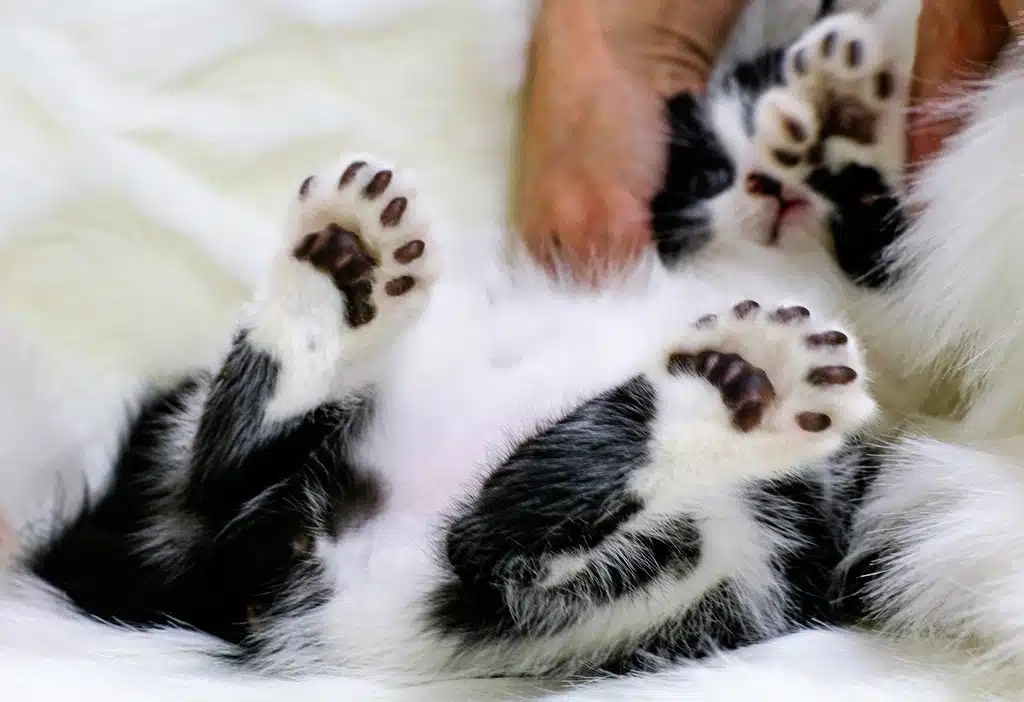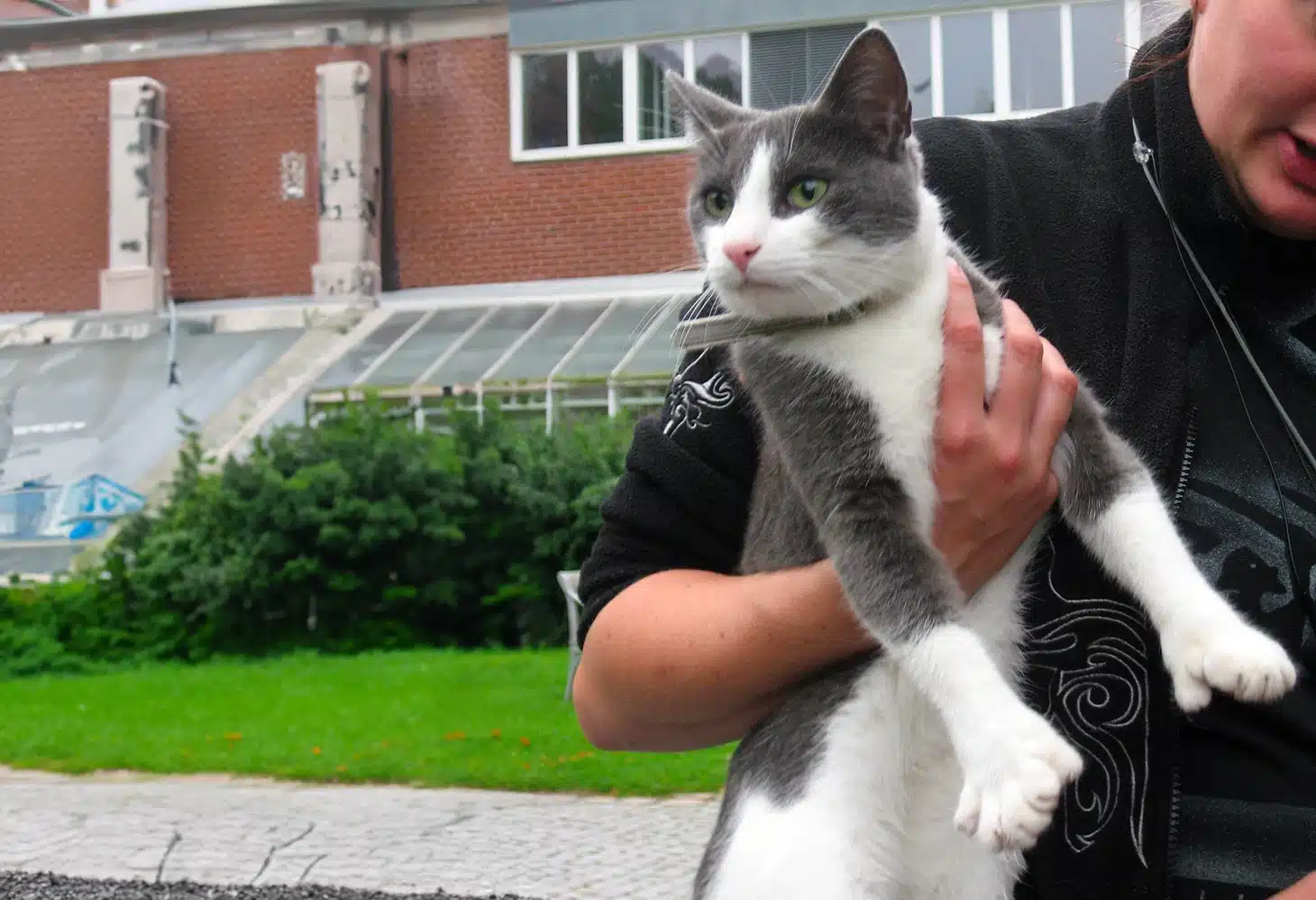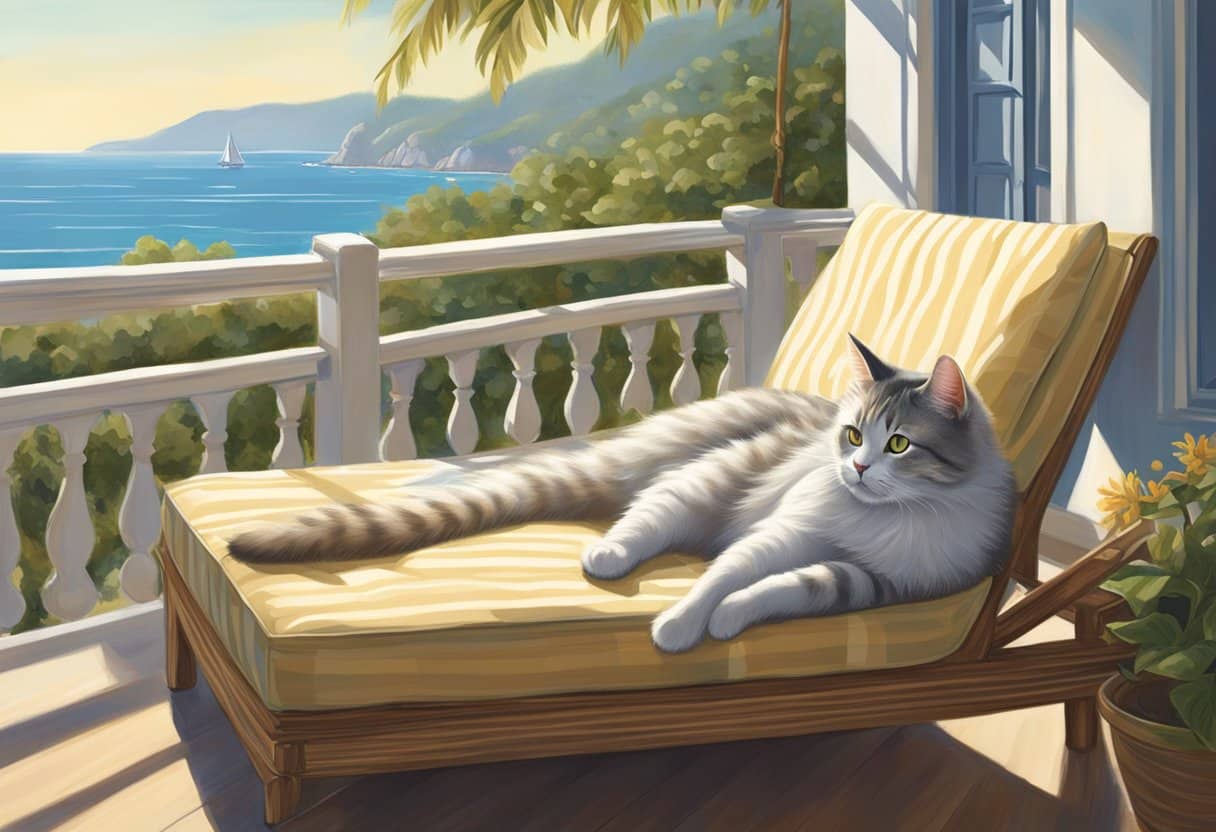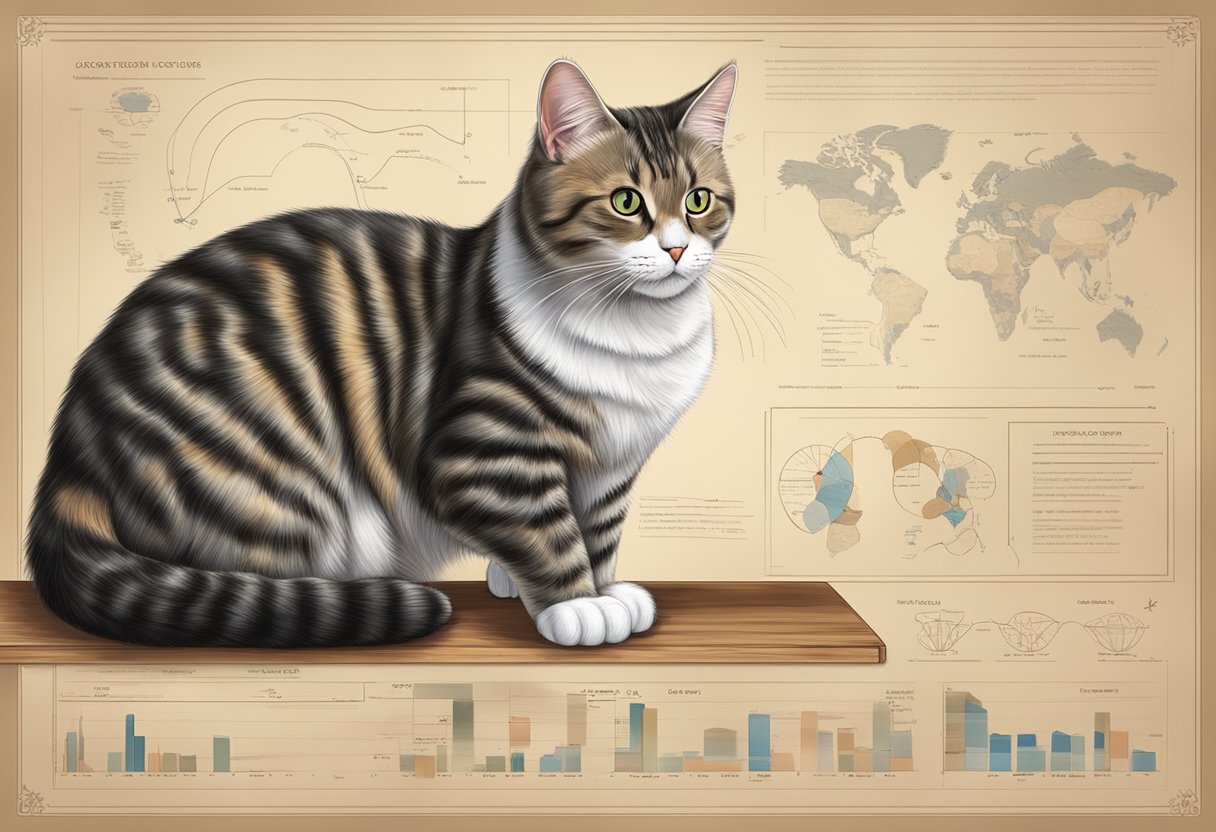Polydactyl cats, also called “Hemingway cats” after their association with author Ernest Hemingway, are a fascinating phenomenon. These cats are characterized by their extra toes, a genetic trait resulting in more than the usual number of toes on their paws. While a normal cat has 18 toes, a polydactyl cat may have as many as seven on each paw. The uniqueness of these cats isn’t confined to their toes; it extends to their rich history and ties to cultural figures.
Ernest Hemingway became an aficionado of polydactyl cats after he was gifted a six-toed cat named Snowball by a ship’s captain. His love for these cats has been well-documented and as a result, polydactyl cats are sometimes affectionately referred to as “Hemingway cats.” The author’s residence in Key West, Florida became the Hemingway Home & Museum, where the descendants of his original cats still live, carrying on the polydactyl legacy.
The curiosity surrounding polydactyl cats is not just due to their association with Hemingway; these felines are distinguished by their various shapes, sizes, and personalities. Not specific to any particular breed, this trait can appear in Calicos, Tabbies, Tortoise Shells, and other breeds. Despite facing challenges such as a federal complaint regarding their care, the cats at Hemingway’s home have become a point of interest for tourists and cat enthusiasts alike, contributing to the rich narrative of Hemingway’s cats and their peculiar trait.
What is a Polydactyl Cat?
A polydactyl cat is an interesting feline that exhibits a genetic mutation resulting in more toes than the typical five on the front paws and four on the back paws. This congenital anomaly is known as polydactyly, and can present itself as simply one extra toe on a paw, or as many as two or three additional toes. The charm of these extra toes has garnered attention worldwide, not least from famed author Ernest Hemingway, after whom some polydactyl cats are affectionally termed.
This condition:
- Is typically harmless and does not affect the cat’s overall health.
- May occur on all four paws but most commonly affects the front ones.
Cats with this condition often have a distinctive appearance, thanks to their enlarged paws, which remind some of mittens, giving rise to the nickname “mitten cats.” The link to Hemingway stems from the cat colony that the writer maintained at his home in Key West, Florida, many of whom were polydactyls. This Hemingway House is now a museum, famously inhabited by the descendants of his cats.
This genetic trait is inherited in an autosomal dominant manner, which means that only one parent needs to possess the gene to pass it on. Moreover, while any cat can be polydactyl, certain breeds like the Maine Coon historically showed a higher frequency of the trait, thought to be an advantage for the snowy climates they originated in, as the larger paws acted like snowshoes.

History and Origin of Polydactyl Cats
Ernest Hemingway’s Influence
Ernest Hemingway, the esteemed author, profoundly impacted the notoriety of polydactyl cats. It’s said he was gifted a white six-toed cat by a sea captain, which began the association between polydactyls and the Hemingway name. The Hemingway Home in Key West is now a sanctuary for these special felines, with some believing the proliferation of polydactyl cats in the United States can be traced back to Hemingway’s initial brood.
Hemingway Cat
A “Hemingway Cat” is another name for polydactyl cats, rooting from the author’s fondness for them. These cats often have more than the usual number of toes on their paws—typically presenting this feature in their front paws, though it can appear on all four. This trait has garnered fascination worldwide, even leading to features in Guinness World Records for cats with the highest number of toes.
Genetic Mutation and Prevalence
Polydactyly is caused by a dominant genetic mutation. Usually, the front paws are affected, but instances on the hind paws occur. The mutation is not exclusive to any single breed, though it is commonly seen in Maine Coons. The genetic trait is believed to have originated in Europe and was spread globally, in part, through sailing activities as cats with the mutation were favored by sailors for their presumed superior climbing and hunting abilities in ship environments.
Physical Characteristics
Paw Anatomy
Polydactyl cats are most famous for their extra toes. A normal cat’s paws typically have five toes on the front and four on the back. However, these cats may have up to seven toes on each paw due to the polydactyly mutation.
Coat and Appearance
Their coat can come in a variety of colors including white, black, and tabby, appealing to a wide range of preferences. They often resemble Maine Coons in their size and body structure, with a sturdy build that supports their uncommon paws. The Polydactyl’s digits play a part in its agile movements, giving it an advantage in stability and dexterity.
Genetics of Polydactyly
The genetic underpinnings of polydactyly in cats involve a fascinating interplay of inheritance and gene mutation. Researchers have traced this trait to autosomal dominant genes, with specific focus on a gene that plays a pivotal role in limb development.
Gene Inheritance
Polydactylism, particularly noted in the Hemingway cats, is primarily inherited in an autosomal dominant manner. This means that only one copy of the mutant gene is needed to manifest the trait. Each kitten has a 50% chance of inheriting the polydactyl phenotype if one parent carries the gene. The trait is not linked to sex chromosomes, and therefore, it affects male and female cats equally.
Single Point Mutation
A single point mutation in the Sonic hedgehog (SHH) gene is directly associated with polydactyly in cats. The SHH gene is critical for early development and patterning of the limbs. A single DNA base change can alter the gene’s expression, leading to the additional toe formation characteristic of polydactyly. This mutation occurs in the regulatory region of the genome that controls gene expression, which means that while the protein coding region of the SHH gene remains intact, its expression is modified.


Health and Care
A Polydactyl cat requires attentive care focusing on its unique polydactyl trait, ongoing health needs, and general well-being. Ensuring these cats maintain good health involves a partnership with a veterinarian and adherence to routine care practices.
Managing Polydactyly
Polydactyl cats boast a distinctive feature of extra toes, which can range from a single additional digit to multiple. Care for these additional toes is crucial to prevent overgrowth and nail-related complications. A regular nail trimming schedule should be part of the cat’s grooming routine to avoid potential issues such as ingrown nails or walking discomfort.
Health Issues
Like all cat breeds, Polydactyls may face typical feline health concerns. These could include:
- Ear mite treatment: Regular ear checks are necessary to prevent mites and resulting infections
- Flea spraying: Effective flea control helps to keep the cat comfortable and free of parasites
- Worming: A routine deworming plan, as prescribed by a veterinarian, can help maintain internal health
- Annual vaccinations: Keeping up with necessary vaccinations is vital for warding off common infectious diseases
There are no specific health issues unique to Polydactyly in and of itself.
General Care Guidelines
To ensure a Polydactyl’s overall well-being:
- Diet: Provide a balanced diet tailored to their life stage.
- Exercise and Stimulation: They require adequate physical activity and mental engagement.
- Regular Veterinary Check-Ups: Partner with a veterinarian for consistent health evaluations and to address any concerns promptly.
Adherence to these care guidelines will help ensure that Polydactyl cats lead healthy, fulfilling lives.
Behavioral Traits and Training
Polydactyl Cat Personality
Polydactyl cats are often celebrated for their affectionate and sociable nature. They seek human interaction and tend to form strong bonds with their families. Their amiable disposition makes them an excellent choice for households looking for a friendly feline companion.
Activity and Playfulness
The activity level of polydactyl cats usually leans towards the playful side. They have a fondness for climbing and exploring their environment, suggesting their space should be equipped with cat trees or safe high places. These cats also display a propensity for hunting behaviors, which is evident in their playful stalking and pouncing on toys.
Training and Intelligence
Known for their intelligence, polydactyl cats can be trained with the right approach. Positive reinforcement techniques work well, and these felines often respond to training that stimulates their mental and physical abilities. They can learn tricks and commands, harnessing their intelligence to interact with their human counterparts effectively.
Cultural Significance
Mythology and Folklore
Polydactyl cats have roots in mythology and folklore, where they are often regarded as bearers of good luck. The extra toes of these felines were sometimes associated with witchcraft and mystical powers during times when superstitions were rife.
Modern-Day Perception
In modern times, the perception of Hemingway’s six-toed cats has shifted from superstition to fondness and celebrity. These unique cats owe part of their fame to Ernest Hemingway, whose former home in Key West is now a museum that houses many polydactyl descendants of Snowball, his first polydactyl cat. This connection to a famous person has cemented the cats’ status as a heritage and tourist attraction, with visitors often viewing them as living artifacts and cheering symbols of both Hemingway’s legacy and feline peculiarity.
Polydactyl Cats as Pets
Polydactyl cats, often known for their distinctive “mittens,” can make fascinating and affectionate companions. They possess a unique charm, with extra toes on their paws that captivate animal lovers.
Polydactyl Cat Breeds
Although not a breed in its own right, the term polydactyl is typically associated with cats that have more than the usual number of toes on their paws. Hemingway Polydactyl cats are perhaps the most famous, directly connected to writer Ernest Hemingway, whose former home now functions as a sanctuary for these cats. These cats can vary in breed, color, and size, but their additional toes are their unifying trait.
Adopting a Polydactyl Cat
When looking to adopt a polydactyl cat, consider reaching out to shelters or breed-specific rescues, as these cats often end up there. Given their popularity, especially in areas like Key West, Florida, finding a polydactyl cat for adoption may be more accessible. Their front paws often resemble little mittens, which helps identify them. It’s essential to ensure they receive the necessary care and attention during adoption, just like any other cat.
Compatibility with Families
Polydactyl cats are known for their sociable and loving nature, making them well-suited for families. Their dexterity and paws might even make them more adept mousers, a trait popular amongst cat owners. The unusual appearance of their ears and hind paws doesn’t typically affect their health, which makes them just as easy to care for as their counterparts with a standard toe count. Their temperament is largely individual but generally friendly and compatible with a family setting.
The Hemingway Home and Museum
Nestled in the Florida Keys, the Ernest Hemingway Home and Museum is not only a tribute to one of America’s most influential writers but also a sanctuary for a unique breed of polydactyl cats.
Conservation Efforts
The museum actively participates in the conservation of the special breed of polydactyl cats that reside on the grounds. These cats are a genetic quirk, carrying the trait for extra toes. Approximately 60 polydactyl cats are cared for at the property; despite only half displaying the extra toes, all carry the polydactyl gene. This ensures the trait can pass on through the generations, maintaining the lineage made famous by Ernest Hemingway himself.
Tourist Attraction
Each year, the Ernest Hemingway Home and Museum draws visitors from around the globe who are eager to explore the property and its feline inhabitants. The charm of the home extends beyond its literary significance, offering guests a glimpse into Hemingway’s life during his ten years in Key West. The presence of the cats adds a unique dimension to the museum experience, intertwining Hemingway’s legacy with that of his beloved pets.


Notable Polydactyl Cats and Records
Polydactyl cats, known for their extra toes, hold a fascinating place in feline history. Some have become famous through their associations with Hemingway, while others have captured attention due to their unique characteristics.
Famous Polydactyl Cats
Ernest Hemingway’s cats: The most famous polydactyl cats are perhaps those associated with the American author Ernest Hemingway. His first polydactyl cat was named Snow White, and many polydactyl cats residing at the Ernest Hemingway Home and Museum in Key West are believed to be its descendants.
Conch Cats: The term “conch cats” often refers to the polydactyl cats found in Key West, where they are a common and beloved presence.
World Records and Unique Features
World Record: While individual records for specific traits like the number of toes are not well documented, polydactyl cats are celebrated for the variation in their paw digits.
Maine Coon Polydactyls: The Maine Coon breed is known for having a high incidence of polydactylism. These cats are not only sought after for their impressive size but also for their distinctive multi-toed paws.
American Polydactyl: An American polydactyl is not a separate breed but rather a term used to describe any cat in the United States with the polydactyl trait. These cats come in all shapes and sizes, unified by their extra toes.
Frequently Asked Questions


What is the typical price range for a polydactyl cat?
Prices for polydactyl cats may vary widely depending on pedigree, location, and availability. Costs can range from a modest adoption fee to several hundred dollars for a cat with a notable lineage.
How much is a polydactyl cat worth?
The worth of a polydactyl cat also depends on factors such as its breeding, health, and uniqueness of the polydactyl trait. While they may not command exorbitant prices, their rarity and historical significance often make them highly valued by enthusiasts.
What is the origin of the term ‘Hemingway cats’?
The term ‘Hemingway cats’ stems from the famous American writer Ernest Hemingway, who was gifted a white polydactyl cat. His home, now a museum in Key West, Florida, shelters a colony of these cats, many of which are descendants of Hemingway’s original pet.
What breeds are commonly known to have the polydactyl trait?
While polydactyly can occur in many breeds, it is particularly familiar with the Maine Coon breed. However, the trait is not limited to specific breeds and can appear in mixed-breed populations as well.
Are there any health concerns specific to polydactyl cats?
There are no particular health concerns uniquely affiliated with polydactyl cats. The extra digits are generally a harmless genetic trait and do not affect the overall well-being of the cats if they are properly cared for.
How would you describe the personality traits of polydactyl cats?
Polydactyl cats are typically described as friendly and sociable. They often enjoy human companionship, thrive on interaction, and can be quite affectionate with their human families.
Are polydactyl cats rare?
While not exceedingly rare, polydactyl cats are less common than cats with the standard toe count. Their distinctive trait makes them unique, and they are somewhat less frequently encountered in the general cat population.
